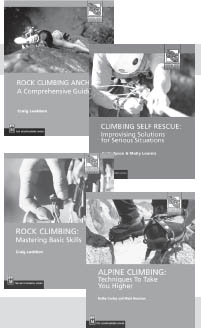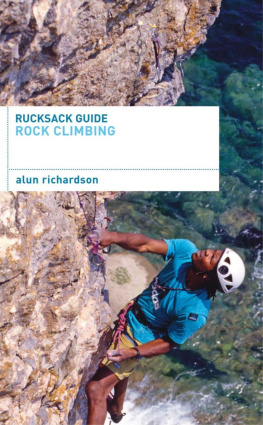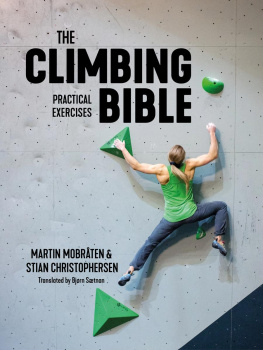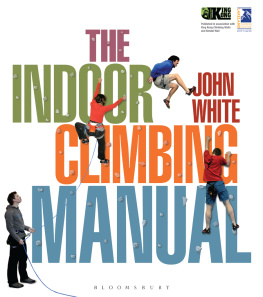Acknowledgments
There are countless people who made this project possible. Without Earth Treks' Climbing Centers, I never would have had the opportunity to work with such a great staff and eager students who have helped mold my experiences as an instructor and climber. Thank you to all the students who have given me the opportunity to help them better their understanding of climbing, as well as mine.
Many thanks to Bill Pelkey, Brad Dorough, Doug Madara, Leigh Saunders, Russ Clune, and LaSportiva for their friendship and support throughout my climbing endeavors. Thank you also to Adrian Ballinger, Brad Mering, Charlotte Jouette, Chris Nance, Chris Warner, Dave Hudson, Eric J. Horst, Mary Metz, Mike Wolfert, S. Peter Lewis, Sam Hanks, Sue Borchardt, and particularly my editor, Julie Van Pelt, for your contributions to this book. To my dad, I finally see the value in rewriting all those sentences when I was a kid.
ABOUT THE AUTHOR
| Matt Burbach has been a climbing instructor since 1995. He was the founding editor of Urban Climber Magazine, and his writings have been published in Gripped and Climbing. He established, developed, and directed the indoor climbing school at Earth Treks' Climbing Centers in Maryland, the largest climbing gyms on the East Coast. Matt has worked in the climbing industry as an instructor, competitor, tech rep, visual merchandiser, and lead organizer of the Petzl, Roc Comp and Smackdown competitions. He is a graduate of the University of Maryland's College of Health and Human Performance and continues to coach climbers on an individual basis. Matt currently lives in the San Francisco Bay area. |  |
THE MOUNTAINEERS, founded in 1906, is a nonprofit outdoor activity and conservation club, whose mission is to explore, study, preserve, and enjoy the natural beauty of the outdoors. The club sponsors many classes and year-round outdoor activities in the Pacific Northwest, and supports environmental causes through educational activities, sponsoring legislation and presenting educational programs. The Mountaineers Books supports the club's mission by publishing travel and natural history guides, instructional texts, and works on conservation and history.
Send or call for our catalog of more than 500 outdoor titles:

The Mountaineers Books 1001 SW Klickitat Way, Suite 201 Seattle, WA 98134 800-553-4453
www.mountaineersbooks.org
 The Mountaineers Books is proud to be a corporate sponsor of The Leave No Trace Center for Outdoor Ethics, whose mission is to promote and inspire responsible outdoor recreation through education, research, and partnerships. The Leave No Trace program is focused specifically on human-powered (nonmotorized) recreation.
The Mountaineers Books is proud to be a corporate sponsor of The Leave No Trace Center for Outdoor Ethics, whose mission is to promote and inspire responsible outdoor recreation through education, research, and partnerships. The Leave No Trace program is focused specifically on human-powered (nonmotorized) recreation.
Leave No Trace strives to educate visitors about the nature of their recreational impacts, as well as to offer techniques to prevent and minimize such impacts. Leave No Trace is best understood as an educational and ethical program, not as a set of rules and regulations. For more information, visit www.LNT.org, or call 800-332-4100.
OTHER TITLES IN THE MOUNTAINEERS
OUTDOOR EXPERT SERIES

Rock Climbing Anchors: A Comprehensive Guide,
Craig Luebben
Climbing Self-Rescue:
Improvising Solutions for Serious Situations
Mastering Basic Skills
Rock Climbing: Mastering Basic Skills,
Craig Luebben
Alpine Climbing: Techniques to Take You Higher,
Mark Houston & Kathy Cosley
OTHER TITLES YOU MIGHT ENJOY FROM
THE MOUNTAINEERS BOOKS

Mountaineering: The Freedom of the Hills, 8th Edition,
The Mountaineers
The climber's biblecomplete, authoritative instruction in an
easy-to-use format.

High Infatuation:
A Climber's Guide to Love and Gravity,
Steph Davis
One of the most accomplished female climbers in the world affirms the joy in following your dreams and passionsand explores what it means to live a truly adventurous life.

Kilimanjaro & East Africa: A Climbing and Trekking Guide,
2nd Edition, Cameron Burns
Climb East Africa's highest peaksvia non-technical and
technical routesin this updated guide to Kilimanjaro, Mount
Kenya, and more.
Available at fine bookstores and outdoor stores, by phone at 800-553-4453 or on the Web at www.mountaineersbooks.org

CHAPTER 1

Indoor Climbing
Climbing is a unique activity that people of different abilities and ages can enjoy together. It takes us out of our normal horizontal world and into a vertical environment that is physically demanding and mentally challenging. Some climbers choose to reach high peaks of the world, like the summit of Mount Everest. Others enjoy climbing at the local rock faces after work with their friends. And still others choose to climb up frozen waterfalls. The avenues of climbing are extremely varied, each with its own unique environment, set of technical skills, and physical demands.
Gym climbing, climbing indoors on fabricated climbing-wall structures, is the fastest growing aspect of climbing. There are several hundred indoor climbing gyms in the United States and Europe and that number is constantly on the rise. Ask gym climbers why they choose to climb indoors and a typical response is because it's fun. The attraction stems from the physical, mental, and even social benefits that gym climbing provides.
Indoor climbing challenges both the body and the mind. Although climbing may be perceived as an upper bodyintensive activity that develops Herculean shoulders and Popeye forearms, every major muscle group in the body contributes to climbing's physical demands. Tough climbs done even with good technique can leave your whole body sore the next day. The full-body aspect of climbing not only develops muscle stabilization and increases strength, but also can improve your joint flexibility and range of motion. And the physical aspect of climbing is just a tip of the iceberg.
Climbing is as much a cerebral activity as it is physical. The excitement comes from the problem-solving skills needed to figure out a particular movement and then actually complete that move. You have to anticipate what hold you want to grab next or how to shift your weight over your feet. The 20 feet of air under your feet as you lunge for the next hold can provide a feeling that no other activity can. The satisfaction after grabbing the hold is unparalleled, too. Climbing demands complete focus on the task at hand, clearing the mind of daily distractions.









 The Mountaineers Books is proud to be a corporate sponsor of The Leave No Trace Center for Outdoor Ethics, whose mission is to promote and inspire responsible outdoor recreation through education, research, and partnerships. The Leave No Trace program is focused specifically on human-powered (nonmotorized) recreation.
The Mountaineers Books is proud to be a corporate sponsor of The Leave No Trace Center for Outdoor Ethics, whose mission is to promote and inspire responsible outdoor recreation through education, research, and partnerships. The Leave No Trace program is focused specifically on human-powered (nonmotorized) recreation.




